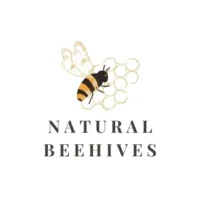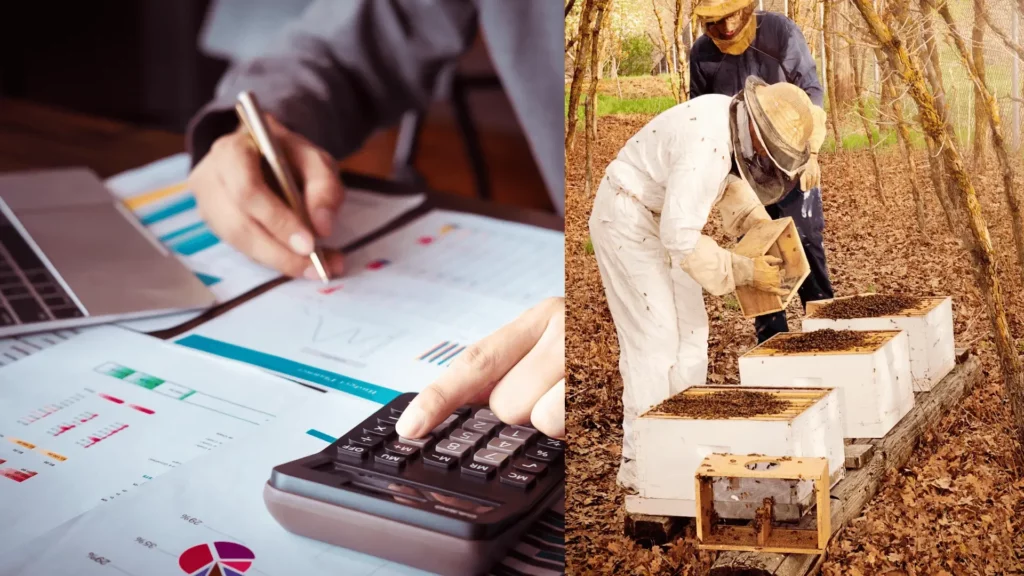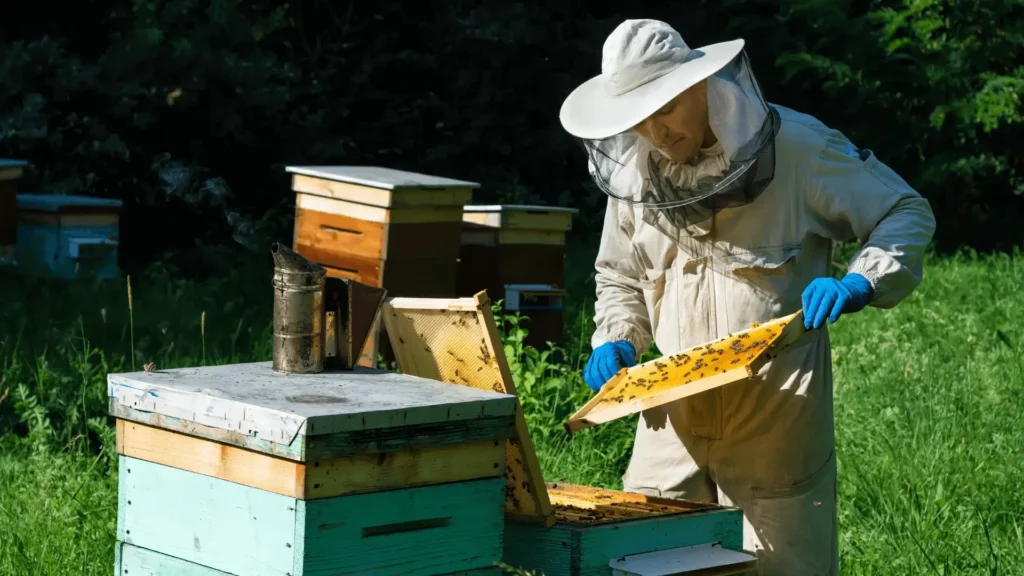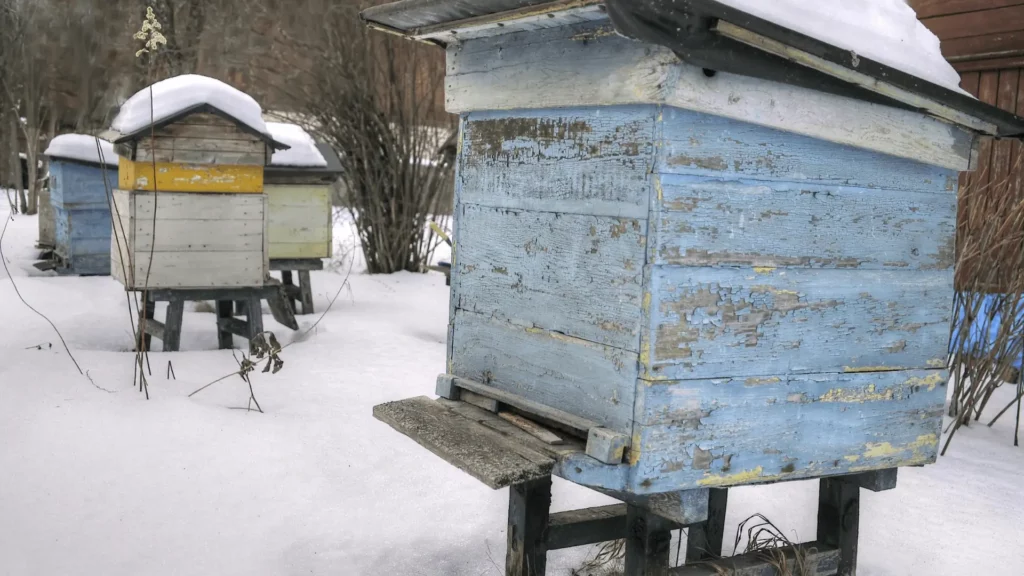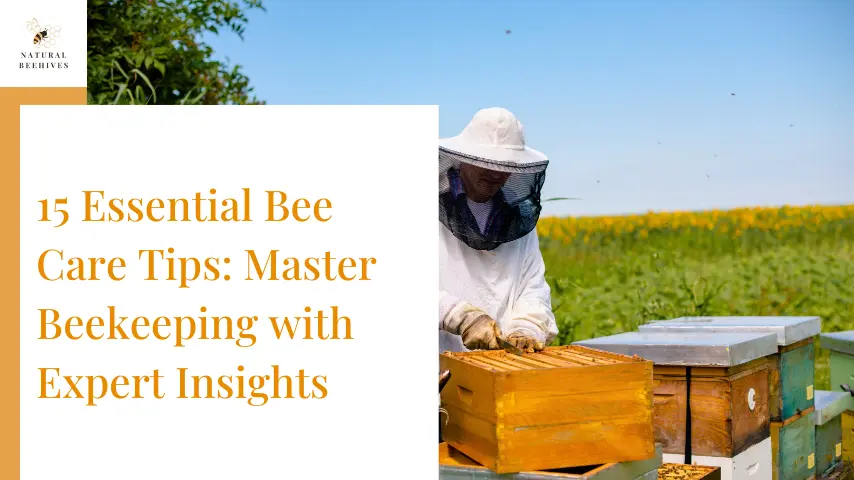
Are you ready to embark on a fascinating journey into the world of beekeeping? Whether you’re a novice or an experienced beekeeper, our comprehensive guide to bee care will equip you with 15 essential tips to master this rewarding craft in 2024.
From providing the perfect home for your buzzing friends to understanding their intricate biology, we’ll cover everything you need to know. Discover:
• How to choose the ideal location for your Langstroth hive
• Essential equipment for successful beekeeping
• Secrets to effective hive management and regular inspections
• Strategies to combat pests like varroa mites and maintain bee health
• Seasonal tasks to keep your colony thriving year-round
Get ready to elevate your beekeeping skills and contribute to the vital role bees play in our ecosystem. Let’s dive in and unlock the secrets to becoming a bee care expert!
Providing a Suitable Home for Bees
Creating the perfect home for your buzzing friends is crucial for successful beekeeping. Let’s explore some key factors to consider when setting up your hive.
Choosing the Right Hive Type
The Langstroth hive is a popular choice among beekeepers. Its modular design allows for easy management and expansion.
This type of hive consists of stackable frame boxes, making it simple to add or remove space as needed.
Location, Location, Location
Selecting the right spot for your colony is vital. Look for a place with:
– Morning sunlight
– Afternoon shade
– Protection from strong winds
– Easy access for you
Remember, bees need a stable environment to thrive.
Water Source Nearby
Bees need water, just like us! Provide a shallow water source near the hive.
A birdbath with stones for landing spots works great. This prevents bees from seeking water in your neighbor’s pool!
Hive Entrance Considerations
Face the hive entrance away from foot traffic. This reduces disturbances and keeps your bees happy.
Also, ensure the entrance is slightly tilted forward. This helps drain any rainwater that might enter the hive.
A well-chosen Langstroth hive, placed in a suitable location with access to water, provides the foundation for a thriving bee colony.
Essential Beekeeping Equipment
Getting started with beekeeping requires some basic gear. Let’s cover the essentials you’ll need for your new hobby.
Protective Gear
First and foremost, protect yourself! You’ll need:
– A bee suit or jacket
– Gloves
– A veil
These items shield you from stings while working with your bees.
Hive Tools
A hive tool is a beekeeper’s best friend. This versatile instrument helps you:
– Pry apart hive components
– Scrape away excess wax
– Lift frames for inspection
Smoker
A smoker is essential for calming bees during hive inspections. It masks alarm pheromones, making your bees more docile.
Remember, the key is to use cool smoke in small amounts.
Equipping yourself with protective gear, hive tools, and a smoker forms the basic foundation for safe and effective beekeeping practices.
RELATED: Bee Nest Types: Unraveling the Fascinating Diversity of Bee Homes
Understanding Bee Biology and Behavior
Diving into the secret life of bees is fascinating! Let’s explore the dynamics of a hive and the biology of these incredible insects.
The Hierarchy of the Hive
A bee colony operates like a well-oiled machine, with each bee playing a crucial role:
1. Queen Bee: The heart of the colony
2. Worker Bees: The tireless laborers
3. Drones: The male bees
The Queen Bee’s Reign
The queen bee is the superstar of the hive. She’s responsible for laying eggs – up to 2,000 per day!
Her pheromones also maintain harmony within the colony. Talk about girl power!
Worker Bees: The Unsung Heroes
Worker bees are all female and make up the majority of the hive. These busy bees have various jobs throughout their lifetime:
– Nursing young bees
– Building comb
– Guarding the hive
– Foraging for food
It’s like a bee career ladder!
The Dance of the Bees
Ever heard of the waggle dance? It’s not the latest TikTok trend, but a sophisticated communication method bees use to share information about food sources.
A forager bee performs this dance to tell her sisters about:
– The direction of the food source
– The distance to the food
– The quality of the food
It’s like a bee GPS system!
Understanding the complex biology and behavior of bees, from the queen’s reign to the worker’s versatile roles and their unique communication methods, is crucial for successful beekeeping.
Hive Management Techniques
Mastering hive management is key to successful beekeeping. Let’s explore some responsible beekeeping practices that will keep your colonies thriving.
Regular Hive Inspections
Frequent check-ups are crucial. Aim to inspect your hives every 7-10 days during the active season.
During these inspections, look for:
– Signs of a healthy queen (presence of eggs and larvae)
– Adequate food stores
– Any signs of disease or pests
Managing Hive Space
Bees need room to grow, but too much space can be problematic. Here’s how to strike a balance:
1. Add supers (extra boxes) when bees have filled 70-80% of the current box
2. Remove empty frames in the fall to reduce space for winter
Swarm Prevention
Swarming is natural, but it can reduce your honey yield. Prevent it by:
– Providing adequate space
– Splitting strong colonies
– Replacing older queens
Feeding When Necessary
Sometimes, bees need a helping hand with food. Provide sugar syrup when:
– Starting a new colony
– During dearth periods
– Preparing for winter
Remember, the goal is to supplement, not replace, their natural forage.
Successful beekeeping hinges on regular inspections, proper space management, swarm prevention, and supplemental feeding when necessary, all of which contribute to maintaining healthy and productive hives.
RELATED: Bee Hive Guide: Types & Maintenance Tips
Regular Hive Inspections
Developing a profound understanding of your bees starts with regular hive inspections. Let’s dive into the why and how of this crucial practice.
Why Inspect?
Regular inspections allow you to:
– Monitor colony health
– Detect problems early
– Assess honey production
– Understand your bees’ needs
Think of it as a weekly check-up for your buzzing friends!
What to Look For
During inspections, keep an eye out for:
1. Presence of eggs and larvae
2. Healthy brood patterns
3. Adequate food stores
4. Signs of pests or diseases
5. Queen’s performance
How Often to Inspect
In general, aim for:
– Weekly inspections during spring and summer
– Bi-weekly in fall
– Monthly in winter (weather permitting)
Remember, each hive is unique. Adjust your schedule based on your bees’ needs.
Inspection Etiquette
Be gentle and respectful during inspections:
– Work calmly and steadily
– Avoid crushing bees
– Use smoke sparingly
– Close up the hive neatly
Your bees will thank you for your considerate approach!
Regular, careful hive inspections are essential for maintaining healthy colonies, allowing beekeepers to monitor bee health, detect issues early, and adjust management practices as needed.
Feeding and Nutrition
Proper nutrition is crucial for honey production and overall bee health. Let’s explore how to keep your bees well-fed and thriving.
Natural Forage vs. Supplemental Feeding
Bees naturally collect nectar and pollen from flowers. However, there are times when they need our help:
– During nectar dearths
– When starting a new colony
– In preparation for winter
Types of Supplemental Feed
1. Sugar Syrup: A mixture of sugar and water, mimicking nectar
2. Pollen Patties: Protein-rich supplements for brood rearing
3. Candy Boards: Solid sugar cakes for winter feeding
When to Feed
Feed your bees when:
– You see fewer than 2-3 frames of honey in the hive
– During long periods of rainy or cold weather
– In early spring to stimulate brood rearing
Remember, the goal is to support, not replace, natural foraging.
While bees primarily rely on natural forage, supplemental feeding with sugar syrup, pollen patties, or candy boards is crucial during nectar dearths, colony establishment, or winter preparation to ensure optimal bee health and honey production.
RELATED: Beekeeping for Beginners: Your Ultimate Guide to Backyard Beekeeping Success
Pest and Disease Management
Protecting your bees from pests and diseases is crucial for preventing colony loss and maintaining bee health. Let’s explore some common threats and how to manage them.
The Varroa Mite Menace
Varroa mites are perhaps the biggest threat to honey bee health. These tiny parasites:
– Feed on adult bees and developing brood
– Spread viruses throughout the colony
– Can lead to colony collapse if left untreated
Monitoring for Varroa
Regular monitoring is key. Try these methods:
1. Sugar roll test
2. Alcohol wash
3. Sticky board count
Aim to check for mites at least monthly during the active season.
Treatment Options
If mite levels are high, consider these treatment options:
– Oxalic acid vaporization
– Formic acid pads
– Thymol-based products
Always follow label instructions and local regulations.
Other Common Pests and Diseases
Be on the lookout for:
1. Small hive beetles
2. Wax moths
3. American foulbrood
4. European foulbrood
5. Nosema
Integrated Pest Management (IPM)
IPM is a holistic approach to pest control. It involves:
– Regular monitoring
– Cultural controls (like proper hive management)
– Chemical controls when necessary
Remember, prevention is always better than cure!
Effective pest and disease management, particularly against varroa mites, is crucial for maintaining bee health and preventing colony loss, requiring regular monitoring, appropriate treatments, and an integrated pest management approach.
Queen Bee Health and Management
The queen bee is the heart of your hive, and her health directly impacts the success of your colony. Let’s dive into the royal world of queen management.
Queen Bee Basics
The queen’s main jobs are:
– Laying eggs (up to 2,000 per day!)
– Producing pheromones to maintain colony cohesion
A healthy queen means a healthy, productive hive.
Signs of a Good Queen
Look for these indicators:
1. Solid brood pattern
2. Eggs laid consistently in cells
3. Worker bees attending to her
When to Replace a Queen
Consider requeening if you notice:
– Spotty brood patterns
– Aggressive worker behavior
– Decreased egg laying
Sometimes, even a good queen needs replacing after 1-2 years to maintain peak colony performance.
Requeening Process
1. Remove the old queen
2. Introduce the new queen in a cage
3. Allow workers to release her over 3-5 days
4. Check for acceptance and egg laying
Remember, patience is key during this delicate process!
Maintaining a healthy, productive queen through regular assessment and timely replacement when necessary is crucial for the overall success and vitality of your beehive.
Seasonal Beekeeping Tasks
Beekeeping is a year-round endeavor, with each season bringing its own set of tasks. Let’s break down what you need to do throughout the year.
Spring: Awakening and Growth
As flowers bloom, your bees spring into action. Focus on:
1. Inspecting hives for winter survival
2. Cleaning out dead bees and debris
3. Adding supers for honey storage
4. Monitoring for swarm signs
Summer: Peak Activity
The busy season is here! Your tasks include:
1. Regular hive inspections
2. Adding more supers as needed
3. Harvesting honey (yum!)
4. Ensuring adequate ventilation
Watch out for those heavy honey boxes – they can weigh up to 90 pounds!
Fall: Preparation for Winter
As temperatures cool, help your bees prepare:
1. Remove excess supers
2. Treat for varroa mites
3. Ensure adequate honey stores (about 60-90 pounds per hive)
4. Reduce hive entrances
Winter: Rest and Monitoring
Bees cluster to stay warm. Your job is to:
1. Check food stores on warmer days
2. Ensure proper ventilation to prevent moisture buildup
3. Protect hives from harsh winds
4. Plan for the next season
Remember, each climate is different. Adjust your tasks based on your local conditions.
Successful beekeeping requires adapting your management practices to the changing needs of the colony throughout the year, from supporting spring growth to ensuring winter survival.
Environmental Factors and Beekeeping
The environment plays a crucial role in beekeeping success. Let’s explore how you can create a bee-friendly habitat and navigate environmental challenges.
Creating a Bee Paradise
Transform your space into a botanical garden for bees:
1. Plant native flowering plants
2. Provide diverse bloom times
3. Avoid pesticides
Remember, happy bees make more honey!
Climate Considerations
Different climates pose unique challenges:
– Hot climates: Ensure proper ventilation and water sources
– Cold climates: Prepare for long winters with extra insulation
– Wet climates: Protect hives from excess moisture
Urban Beekeeping Challenges
City bees face special hurdles:
1. Limited foraging areas
2. Potential conflicts with neighbors
3. Local regulations
Overcome these by communicating with neighbors and staying informed about local laws.
Creating a bee-friendly environment with diverse native plants, adapting to local climate conditions, and navigating urban challenges are crucial for successful beekeeping in various settings.
RELATED: Winterizing Bee Hives: How to Prepare Your Hives for the Cold Months
Local Beekeeping Communities and Resources
Connecting with fellow beekeepers can supercharge your beekeeping journey. Let’s explore how to tap into your local beekeeping community.
Join a Local Beekeeping Club
Beekeeping clubs offer:
– Hands-on workshops
– Mentorship opportunities
– Equipment sharing
It’s like a support group for bee enthusiasts!
Attend Bee Club Meetings
Regular meetings provide:
1. Latest beekeeping news
2. Problem-solving sessions
3. Opportunities to make beekeeping buddies
Online Communities
Don’t forget virtual resources:
– Facebook groups
– Beekeeping forums
– Local beekeeper blogs
These can be goldmines of information and support.
Local Extension Programs
Many universities offer beekeeping resources:
– Classes
– Publications
– Expert advice
Check your local extension catalog for beekeeping publications.
Engaging with local beekeeping communities through clubs, meetings, online forums, and extension programs provides invaluable support, knowledge, and resources for both novice and experienced beekeepers.
Urban Beekeeping Challenges and Solutions
Urban beekeeping is on the rise, but it comes with its own set of challenges. Let’s explore how to be a successful urban beekeeper.
Space Constraints
Challenge: Limited space for hives
Solution:
– Use rooftops or balconies
– Try vertical hives
– Consider community garden spaces
Neighbor Relations
Challenge: Concerns from neighbors
Solution:
– Educate neighbors about the benefits of bees
– Offer honey as a goodwill gesture
– Ensure your bees have a water source to prevent them from visiting neighbors’ pools
Legal Hurdles
Challenge: Lack of bee-friendly legislation
Solution:
– Research local regulations
– Advocate for bee-friendly laws
– Join local beekeeping associations for support
Foraging Limitations
Challenge: Less diverse food sources
Solution:
– Plant bee-friendly flowers in your garden
– Encourage neighbors to do the same
– Supplement with sugar syrup when necessary
Urban beekeeping presents unique challenges such as space constraints, neighbor relations, legal hurdles, and limited foraging options, but these can be overcome with creative solutions, community engagement, and proper planning
RELATED: Winter Beehive Insulation: A Guide to the Best Materials
Native Bee Conservation
While honey bees get a lot of attention, native bees are crucial for biodiversity. Let’s explore how to support these important pollinators.
Importance of Native Bees
Native bees:
– Pollinate specific local plants
– Are often more efficient pollinators
– Contribute to ecosystem health
Supporting Native Bee Diversity
To help native bees:
1. Plant native flowering species
2. Provide nesting sites (like bare soil or hollow stems)
3. Avoid pesticides
Different Types of Native Bees
Learn about:
– Bumble bees
– Mason bees
– Carpenter bees
– Sweat bees
Each has unique nesting and foraging habits.
Supporting native bee diversity through habitat creation and conservation is crucial for maintaining healthy ecosystems and complementing the pollination services of honey bees.
Honey Harvesting and Processing
The sweet reward of beekeeping is honey harvest time! Let’s dive into the process of collecting and processing this liquid gold.
When to Harvest
Timing is crucial:
– Wait until honey is capped
– Harvest before fall feeding begins
– Leave enough for bees’ winter stores
Harvesting Process
1. Remove supers from hive
2. Brush bees off frames
3. Uncap honey cells
4. Extract honey (manually or with an extractor)
5. Strain and bottle
Honey Yields
Yields vary, but a healthy hive can produce:
– 50-100 pounds of honey per year
– More in good nectar flow years
Remember, always leave enough for your bees!
Processing and Storage
– Strain honey to remove wax and debris
– Store in airtight containers
– Keep in a cool, dry place
Properly stored honey can last indefinitely!
Successful honey harvesting involves Successful honey harvesting involves careful timing, proper harvesting techniques, and appropriate storage practices to ensure the quality and longevity of your honey. By following these steps, you can enjoy the fruits of your beekeeping labor while also ensuring the well-being of your bees.
Conclusion
As we wrap up this comprehensive guide to beekeeping, remember that mastering the art of caring for bees is an ongoing journey. By implementing these 15 essential tips, you’re well on your way to becoming a successful beekeeper. From providing a suitable home and understanding bee biology to managing pests and harvesting honey, each aspect plays a crucial role in maintaining healthy, thriving colonies.
Remember, responsible beekeeping practices not only benefit your hives but also contribute to the broader ecosystem and food security. As you continue your beekeeping journey, stay connected with your local beekeeping community, attend bee club meetings, and never stop learning. Whether you’re an urban beekeeper or tending hives in a rural setting, your efforts make a significant impact on bee conservation and honey production.
We hope this guide has inspired you to elevate your skills and deepen your appreciation for these remarkable insects. Happy beekeeping, and may your hives buzz with success!
